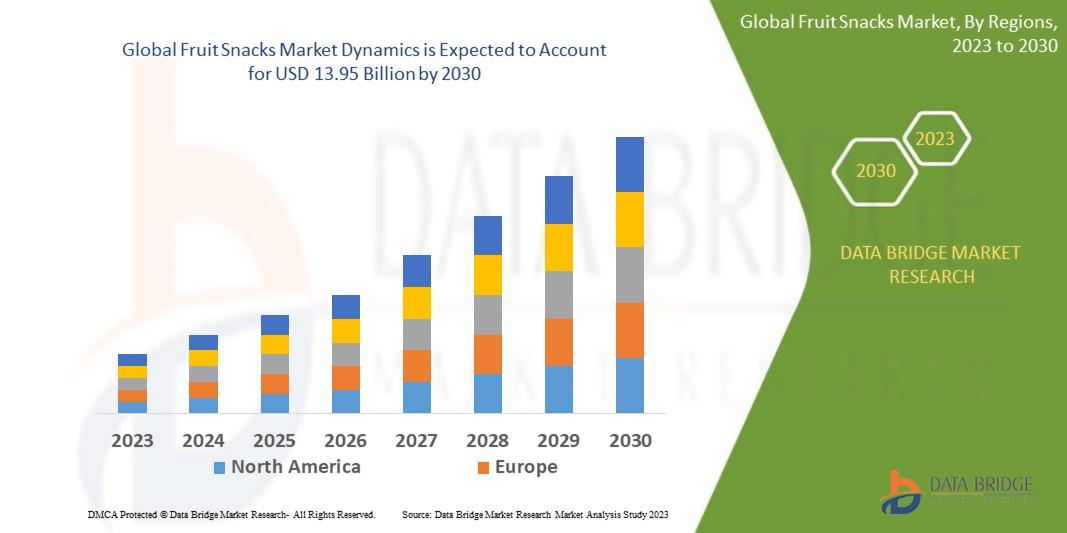
The Fruit Snacks Market is undergoing a flavorful transformation, as consumers worldwide demand healthier, natural, and convenient snacking options. Traditionally marketed toward children, fruit snacks are now reaching a broader audience—including health-conscious adults, athletes, and on-the-go professionals.
As people move away from sugar-laden candies and processed snacks, fruit-based alternatives offer the ideal blend of nutrition, taste, and convenience. The rising popularity of vegan diets, gluten-free products, clean-label foods, and functional ingredients is propelling innovation in this space, making fruit snacks more than just a lunchbox staple.
Get More Details: https://www.databridgemarketresearch.com/reports/global-fruit-snacks-market
Market Overview
The global fruit snacks market was valued at approximately USD 5.5 billion in 2023 and is projected to reach USD 9.2 billion by 2030, growing at a CAGR of 7.4%. This growth is driven by an increasing awareness of health and wellness, rising disposable incomes, and a surge in plant-based dietary preferences.
Key Market Drivers
🍏 Health and Wellness Trends
As consumers prioritize low-calorie, nutrient-dense snacks, fruit snacks offer the perfect alternative to traditional salty or sugary treats. Packed with vitamins, antioxidants, and natural sugars, they appeal to people seeking guilt-free indulgence.
🛒 Convenience and Portability
Modern consumers demand easy-to-carry and ready-to-eat snacks. Fruit snacks—especially in pouch, bar, and strip formats—fit perfectly into this on-the-go lifestyle.
🌱 Rise of Clean Label and Natural Products
Transparency matters. Shoppers now prefer snacks with minimal ingredients, no artificial additives, and clear nutritional labels. Brands responding with organic, non-GMO, and allergen-free fruit snacks are thriving.
🧒 Growing Demand in Children’s Nutrition
Parents are seeking healthy snacks for their kids that are both tasty and nutritious. Fruit snacks serve as a smart replacement for candy, making them a favorite in lunchboxes worldwide.
Popular Product Categories
1. Fruit Bars
Compressed dried fruit blended with nuts, seeds, or grains—ideal for meal replacements and fitness-focused consumers.
2. Fruit Gummies and Chews
Fun and flavorful, these mimic traditional candy but are made with real fruit juice, pectin, and natural sweeteners.
3. Dried Fruit Snacks
Dehydrated apples, mangoes, bananas, and berries deliver intense flavor and long shelf life—great for trail mixes and energy boosts.
4. Fruit Rolls and Strips
A kid-friendly, chewy snack made by pureeing and drying fruit, often with no added sugar or preservatives.
Regional Market Insights
- North America dominates the market due to strong retail networks, rising health awareness, and product innovation.
- Europe follows with a preference for organic and natural fruit-based snacks.
- Asia-Pacific is the fastest-growing region, driven by rising incomes, urbanization, and the Westernization of diets.
- Middle East & Africa are emerging markets, increasingly adopting healthier snacking trends among urban consumers.
Top Market Players
- General Mills, Inc. – Famous for Fruit Roll-Ups and Nature Valley bars.
- The Kellogg Company – Offers Stretch Island Fruit Co. and other natural snack lines.
- SunOpta, Inc. – A leading supplier of organic dried fruits and private-label snacks.
- Bare Snacks – Specializes in baked fruit chips with no added sugar.
- Welch’s – Popular for fruit snacks made with real fruit juice.
Challenges in the Market
- High Sugar Content in Some Brands – Many fruit snacks still contain added sugars and concentrates, conflicting with their health image.
- Price Sensitivity – Organic and clean-label snacks often carry premium price tags, limiting access for some demographics.
- Shelf Stability and Preservation – Maintaining texture and taste without preservatives remains a technical challenge for natural products.
Future Trends and Innovations
🌿 Functional Fruit Snacks
Infused with superfoods, probiotics, collagen, or CBD, these snacks aim to combine health benefits with indulgence.
🌍 Sustainable Packaging
Brands are investing in eco-friendly, biodegradable packaging to meet environmental expectations.
🧬 Customization and Personalization
AI and data-driven platforms are enabling personalized snack boxes based on consumer preferences and dietary needs.
🧁 Snackable Fruit Desserts
Fruit snacks are entering the dessert space with fruit-based pudding cups, frozen bites, and yogurt blends.
Conclusion
The Fruit Snacks Market has evolved into a dynamic and rapidly growing segment of the global food industry. With the convergence of health trends, lifestyle changes, and innovation, fruit snacks are no longer just a treat for kids—they’re a nutritious, delicious, and functional choice for everyone.
As consumers demand cleaner, smarter, and more sustainable snacking options, fruit snack brands that embrace transparency, innovation, and taste will lead the way.
FAQs
1. What makes fruit snacks healthy?
Fruit snacks made from real fruit, with no added sugars or preservatives, are rich in fiber, antioxidants, and natural vitamins, making them a healthy alternative to processed snacks.
2. Are all fruit snacks vegan and gluten-free?
Not always. While many are, it's important to check the label for gelatin (animal-derived), added sugars, or gluten-based ingredients.
3. Who are the biggest consumers of fruit snacks?
While traditionally marketed to children, the fastest-growing segments include health-conscious adults, athletes, and busy professionals.
4. How is the fruit snacks market addressing sustainability?
Brands are moving toward biodegradable packaging, using renewable ingredients, and sourcing fruit from ethical and sustainable farms.
5. What are the most popular fruit snacks in the market?
Fruit bars, dried fruit, gummies, and fruit rolls are among the most popular, especially those that emphasize natural, organic, and functional ingredients.

